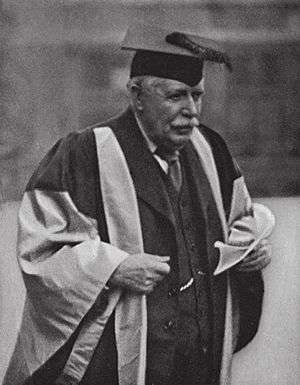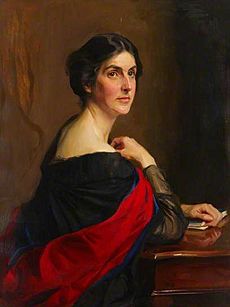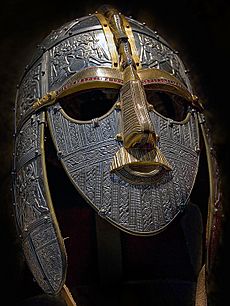Hector Munro Chadwick facts for kids
Quick facts for kids
Hector Munro Chadwick
|
|
|---|---|
 |
|
| Born | 22 October 1870 Thornhill Lees, Yorkshire, England
|
| Died | 2 January 1947 (aged 76) Cambridge, England
|
| Alma mater | |
|
Notable work
|
|
| Spouse(s) | |
| Scientific career | |
| Institutions | |
| Academic advisors | |
| Influences | |
Hector Munro Chadwick (born October 22, 1870 – died January 2, 1947) was an English scholar. He was a philologist, which means he studied languages and their history. Chadwick was a professor at the University of Cambridge. He led the department that studied Anglo-Saxon, Norse, and Celtic cultures.
Chadwick was known for encouraging different subjects to work together. He wanted people to combine history, archaeology, and language when studying ancient peoples like the Celts and Germanic peoples. He also developed important ideas about the "Heroic Age" in human societies. He wrote many influential books and taught many students who became famous scholars themselves. He often worked with his wife, Nora Kershaw, who was also a scholar.
Contents
Chadwick's Early Life and Family
Hector Munro Chadwick was born in Thornhill Lees, England, on October 22, 1870. He was the third son of Edward Chadwick and Sarah Anne Bates. His father was a Reverend, a type of church leader.
Hector was the youngest child and had a very close bond with his sister, Dora. She taught him to read and write, and even taught him Latin. Hector later said that Dora "brought me up." His father encouraged his children to study hard. He would jokingly tell Hector that a bear would take him away if he didn't learn Latin!
School Days and Learning
Chadwick went to Bradford Grammar School for a short time. He was a very smart student, but he didn't always like school. He sometimes pretended to be sick to stay home. From 1885 to 1889, he attended Wakefield Grammar School. He traveled 8 miles each day to get there. During his commute, he taught himself German.
At Wakefield, Hector loved playing tennis and helped manage the school's cricket club. His classmates remembered him as a determined but shy boy. He was always happy to help his friends with their Latin homework. These traits – shyness, intelligence, determination, and helpfulness – stayed with him his whole life.
University Life at Cambridge
In 1889, Chadwick went to Clare College, Cambridge. He traveled to Scotland, Wales, and the Isle of Man that summer. While at Cambridge, he also visited other countries in Europe with his brother Edward.
Chadwick was a brilliant student. In 1892, he earned his first degree, a Bachelor of Arts (B.A.). The next year, he got a top grade in Philology, which is the study of language in historical and cultural context. From 1893 to 1899, he was a Fellow at Clare College, meaning he was a junior academic.
During this time, he read a book called The Viking Age by Paul Du Chaillu. This book sparked his deep interest in the ancient cultures of Northern Europe. The book looked at its subject from many angles, like history, archaeology, and language. This multi-subject approach became a key part of Chadwick's own work.
Chadwick's Career Begins

Chadwick returned to Cambridge in 1895 and started teaching Old English. He focused on studying the early history of Northern Europe. He earned his Master of Arts (M.A.) degree in 1896.
Chadwick was quickly seen as a very talented teacher. He taught in an informal way and was especially good at one-on-one meetings with his students. Many students said these meetings at his home helped shape their academic careers. He became very popular, and his students even gave him the nickname "Chadders." He believed that female students should be treated the same as male students, which was unusual at the time. Many of his students went on to become important scholars.
In 1899, Chadwick published his first book, The Cult of Othin. In this book, he studied how the god Odin was worshipped by different Germanic peoples. He used evidence from language, literature, and archaeology. He concluded that the worship of Odin was similar among all Germanic groups, including the Anglo-Saxons and Norse peoples.
In 1905, Chadwick published Studies in Anglo-Saxon Institutions. This book was considered the best work on Anglo-Saxon society at the time. In 1907, he published his major work, The Origins of the English Nation. This book explored where the Anglo-Saxons and the English people came from. It was praised for combining archaeology, history, and language studies from England and Northern Europe.
The Idea of the Heroic Age
In 1912, Chadwick published The Heroic Age, one of his most important books. In this work, he looked at how the epic poems of the Greek Heroic Age were similar to those of the Germanic Heroic Age. He also considered Celtic, Roman, and Slavic epic poems, showing his wide knowledge.
Chadwick suggested that a "Heroic Age" was a special time in the history of many human societies. During these times, brave warriors were very important. Courage and fighting skills were valued above everything else. Chadwick believed that a Heroic Age was not a primitive time, but a time of youth, energy, and change. He thought these ages often appeared when tribal societies met more advanced civilizations, like when Germanic peoples met ancient Rome. He also believed Heroic Ages happened among the Celts and Slavs. The Heroic Age became a key book in the study of comparative literature, which compares literature from different cultures.
Leading Changes at Cambridge
After his professor, Walter William Skeat, passed away in 1912, Chadwick was chosen to take his place. He became the Elrington and Bosworth Professor of Anglo-Saxon at Cambridge. He held this important position until 1941. From this point on, Chadwick spent most of his time teaching and managing the university department.
Chadwick wanted to expand the department beyond just language studies. He wanted it to cover not only Anglo-Saxons but also all Germanic studies and Celtic studies. He believed that studying language was a way to understand the early history of these peoples. He pushed for scholars to use original historical documents and sources. Despite some disagreement, Chadwick succeeded in changing the rules in 1917. His department then covered history, archaeology, and the study of culture, including religion and social customs.
Chadwick also helped change other parts of Cambridge University. He worked with friends to improve English studies and transform the language courses. His changes faced some opposition, but Chadwick was determined and skilled. He managed to get his reforms accepted.
Working with Nora Kershaw

On May 4, 1922, Chadwick married Nora Kershaw, who had been one of his students. Nora became a Fellow at Newnham College, Cambridge, and a close academic partner to Chadwick. They published several important books together. Nora was a talented language scholar.
The Chadwicks lived in an old paper-mill outside Cambridge. They loved animals and kept many cats and dogs, naming them after characters from Beowulf and Norse mythology. Their home became a gathering place for people interested in early Germanic and Celtic literature. Nora often drove them and their students to visit archaeological sites and take trips to Wales, Scotland, and Ireland. Chadwick was proud of his Scottish background and loved all things Celtic.
In 1927, Chadwick moved his department to the new Faculty of Archaeology and Anthropology. It became known as the Department for Anglo-Saxon and Kindred Studies. He wanted its courses to be a broad, independent subject, much like the study of Classics (ancient Greek and Roman culture).
The Growth of Literature
Even though Chadwick was busy with university duties, Nora encouraged him to start writing again. He thought his teaching was more important, but Nora convinced him to write a book together. This led to what many consider the most important part of Chadwick's career.
The Chadwicks continued the research Hector had started in The Heroic Age. They originally planned to compare literature, archaeology, and civilization of the Viking Age and Ancient Greece. However, Hector read a book that described how the Shahnameh, a Persian epic poem, affected people.
Impressed by how similar the Shahnameh was to Greek epic poetry, the Chadwicks decided to make their project much bigger. It grew to include the oral literature of many different peoples. The result was their three-volume work, The Growth of Literature (published between 1932 and 1940).
Hector wrote most of the first volume, which covered ancient oral literature in Europe. Nora collected material on Irish literature. Nora wrote most of the second volume, but Hector wrote parts on Slavic, Hebrew, and Indian literature. Nora also wrote most of the third volume, which included sections on Tatar, Polynesian, and African literature. Hector wrote the final section, which summarized everything in all three volumes. The Chadwicks knew many of the languages covered in the book. They used literary, historical, language, anthropology, and archaeological evidence. This work is seen as a groundbreaking and masterful study, and Chadwick's finest achievement.
Later Years and Legacy

During World War II, many younger staff members left the university. Chadwick, even though he was getting older, once again did most of the teaching in his department. In 1940, he wrote an important article about the Sutton Hoo burial site. He suggested that the magnificent burial belonged to Rædwald of East Anglia, an early English king.
Chadwick retired as professor in 1941 but continued to teach and lead his department. He believed that Anglo-Saxon studies should be a separate and broad subject, like the Classics. He also argued against making philology (the study of language) a required subject for all students.
Chadwick thought that the broad approach he used for Anglo-Saxon studies should also be used for studying other peoples. He explored this idea in his book The Nationalities of Europe and the Growth of National Ideologies (1945). He believed that understanding the history, languages, and literature of different countries was essential.
Chadwick became very ill in 1946. He passed away in Cambridge on January 2, 1947. His final work, Early Scotland, was finished by Nora and published after his death.
Hector Munro Chadwick had a lasting impact on scholarship. He is remembered for being a polymath, someone with knowledge in many different subjects. He pioneered the idea of using many different fields of study to understand early European cultures. At Cambridge, he is known as the founder of the Department of Anglo-Saxon, Norse and Celtic. He guided many generations of scholars who made important contributions to knowledge.
Selected Works
Books
- The Cult of Othin, 1899
- Studies in Old English, 1899
- Studies on Anglo-Saxon Institutions, 1905
- The Origin of the English Nation, 1907
- The Heroic Age, 1912
- (With Nora K. Chadwick) The Growth of Literature, 1932–1940
- The Study of Anglo-Saxon, 1941
- The Nationalities of Europe, 1945
- (Edited by Nora K. Chadwick) Early Scotland, 1949
Articles
- "The Origin of the Latin Perfect in -ui", 1894
- "Ablaut Problems in the idg. Verb", 1899
- "The Oak and the Thunder God", 1900
- "The Ancient Teutonic Priesthood", 1900
- "Early Inscriptions in the North of England", 1901
- "Early National Poetry", 1907
- "Ancestor Worship and the Cult of the Dead: Teutonic", 1908
- "Calendar: Teutonic", 1910
- "Some German River Names", 1913
- "The Sutton Hoo Ship Burial VII: Who was he?", 1940
- "Why Compulsory Philology? II", 1946


